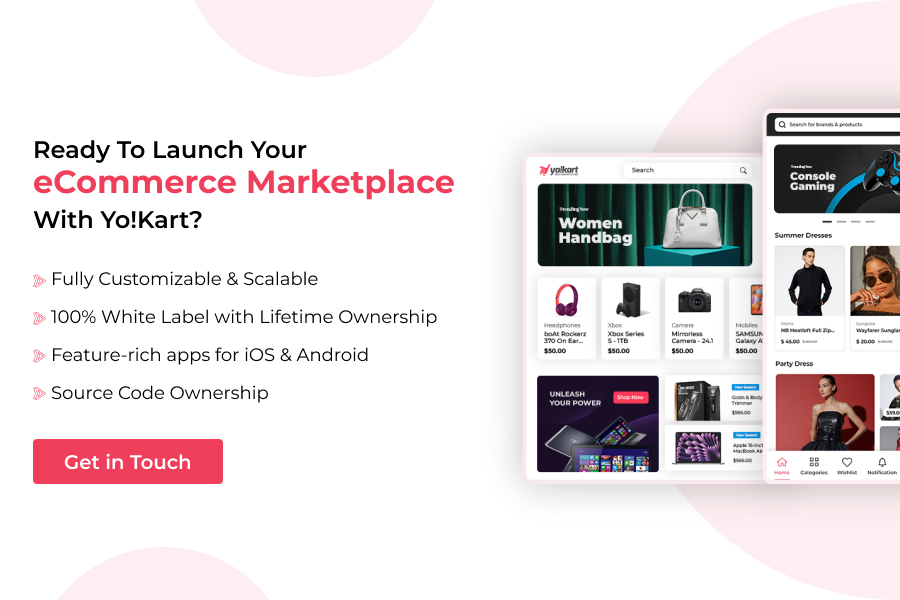Building a marketplace platform can be a lucrative venture, but launching a fully-featured product from day one is often expensive, time-consuming, and risky. That’s why smart founders start with an MVP (Minimum Viable Product).
According to Statista, global online marketplace sales are projected to reach over $7.4 trillion by 2025, with platforms like Amazon and Etsy leading the charge. In fact, 67% of global eCommerce sales are generated through marketplace models. According to a CB Insights report, one of the leading reasons startups fail, accounting for 35% of cases, is the lack of market need. Developing an MVP helps mitigate this risk by enabling businesses to validate product-market fit early in the process, ensuring they build something customers actually want.
In this guide, we’ll walk you through how to build an MVP marketplace, including planning, features, tech stack, and launch strategies to help you turn your marketplace idea into a tangible, testable product—without burning through your budget or time.
Table of Contents
What is an MVP Marketplace?
An MVP (Minimum Viable Product) marketplace is the leanest functional version of a digital platform that facilitates the exchange of products, services, or experiences between two or more user groups, typically buyers and sellers. The purpose of building an MVP is to validate the business model with minimal resources by launching with just enough features to solve a core problem and deliver value to early users.
Unlike a fully developed marketplace that may include a comprehensive feature set, such as advanced filtering, AI-powered recommendations, loyalty programs, or multi-language support, an MVP marketplace focuses solely on what is essential to operate, measure interest, and learn from user interactions.
This approach has become a critical strategy for modern startups and digital entrepreneurs, especially in high-investment industries like eCommerce, on-demand services, and peer-to-peer platforms. It allows founders to avoid overbuilding, reduce time to market, and make data-driven product decisions based on real user feedback.
Why Start with an MVP Marketplace?
Launching a full-scale marketplace platform without market validation is a risky and expensive move. That’s why building an MVP marketplace is a smart starting point for startups looking to test the waters, especially in competitive and fast-moving markets like the US.
An MVP allows you to create a lean version of your platform with essential features only, just enough to connect buyers and sellers and deliver value. This approach lets you launch faster, spend less, and learn more before making large investments.
- Faster Time to Market:
An MVP can be developed in 4-12 weeks, giving you a head start on market entry and user acquisition. In contrast, full-scale marketplaces can take 6 months to over a year to build.
- Cost-Efficiency:
Custom marketplace development in the US can cost over $50,000 to $500,000, while an MVP can be launched for $5,000-$50,000, depending on the tools or tech stack you choose.
- Validate Product-Market Fit:
Nearly 35% of startups fail because there’s no market demand (CB Insights). An MVP helps you test demand early and refine your offering based on real user feedback, not assumptions.
- Lower Risk, Higher Flexibility:
Launching lean gives you the flexibility to pivot or iterate based on usage patterns. You avoid overbuilding and can prioritize features that actually drive engagement and revenue.
- Attract Early Revenue & Investors:
With basic monetization (e.g., commissions, listing fees), an MVP can generate revenue from Day 1. This traction helps you attract funding or grow organically.
Ready to Launch a Powerful MVP Marketplace that Scales?
Step-by-Step Process to Build an MVP Marketplace
Building an MVP marketplace involves more than just coding—it requires a strategic approach to product design, business modeling, and user experience. A successful MVP connects buyers and sellers with minimal functionality, enabling you to test your concept quickly and iterate based on real-world feedback.
Here are the detailed steps to build an MVP marketplace:
1. Identify Your Niche and Define Your Marketplace Type
Before directly diving into development, it’s essential to clearly define the niche and structure of your marketplace. Ask yourself questions like:
- Who are my target users? (e.g., freelancers, retailers, service providers, renters)
- What pain point does my marketplace solve?
- What type of transactions will occur? (e.g., product sales, service bookings, rentals)
- Will the business model be B2B, B2C, C2C, or a hybrid?
Example: A marketplace for health supplements (B2C) solves the problem of consumers struggling to find trusted, high-quality vitamins and wellness products by connecting them directly with vetted brands and expert recommendations.
2. Define the Core Features for MVP
Avoid the temptation to overbuild. Your MVP should contain only the must-have features necessary for the platform to function. These typically include:
For Buyers:
- User Registration & Login
- Product/Service Search & Browsing
- Book or purchase functionality
- Checkout & Payment Integration
- Basic communication with sellers (optional at MVP stage)
- Messaging System
- Order History / Purchase Tracking
For Sellers:
- Seller registration & profile management
- Create and manage listings
- Track orders or inquiries
- Basic Analytics Dashboard
- Messaging with Buyers
- Payout Setup
For Admin:
- User and listing management
- Product Catalog
- Order Monitoring
- Content Management System (CMS)
- Reports & Analytics
- Support ticket or messaging system
- Payment and commission monitoring
3. Choose the Right Development Approach
Your choice of development path depends on your goals, budget, and timeline. Here are two common approaches to build an MVP marketplace:
A. Custom Development
Custom development involves building your MVP marketplace from the ground up, providing complete control over every aspect of your platform, from the user interface to backend logic and third-party integrations. However, it also requires a higher initial investment and a longer timeline. Additionally, you’ll need to hire a skilled team of developers to build the platform from scratch.
Pros:
- Full control over features, design, and user experience
- Scalable infrastructure tailored to your long-term vision
- Ability to implement highly specialized or unique workflows
Cons:
- High upfront development costs
- Longer time to launch
- Requires ongoing maintenance and technical support
- Higher risk of scope creep
- Longer time to validate the idea
- Unpredictable costs
B. Readymade Marketplace Software
Readymade Marketplace Software like Yo!Kart offers a fast, cost-effective way to launch your MVP. These solutions come equipped with essential marketplace features and are designed to be customizable, allowing you to tailor branding and some workflows without building everything from scratch. This approach is best suited for businesses to validate their idea quickly with minimal technical overhead, as it allows them to focus on user acquisition, feedback, and traction rather than backend infrastructure.
Pros:
- Rapid deployment (typically within a few days or weeks)
- Lower upfront costs compared to custom builds
- Backed by dedicated support and detailed documentation
- Pre-built core features and integrations
- Secure, scalable architecture
- Integrated security standards
- Customization capabilities to reflect a unique brand identity
Cons:
- May require developer input for advanced customizations
Choose the Right Marketplace Software to Build an MVP Marketplace
4. Design for Mobile Responsiveness and UX
With over 62.45% of marketplace traffic coming from mobile devices, your MVP must be mobile-first. Focus on:
- Clean UI and intuitive navigation
- Fast-loading pages (under 3 seconds)
- Clear CTAs for buying, selling, and registering
- Minimal steps to complete actions (e.g., checkout or listing creation)
5. Test the MVP Before Launching
Before releasing an MVP, it is essential to conduct internal testing to ensure that your marketplace is stable, functional, and ready for external feedback. This stage helps catch bugs, usability issues, and broken workflows early, saving you from costly fixes or poor first impressions post-launch. Hence, focus on:
- Verifying all core workflows (buyer, seller, admin)
- Identifying and fixing critical bugs or UI issues
- Ensuring payments, bookings, and transactions work reliably
- Checking that basic analytics are tracking user behavior properly
6. Launch and Collect Data to Analyze & Iterate
Start with a soft launch, targeting a small group of early users. This controlled rollout allows you to test the end-to-end experience, identify usability issues, and gather honest feedback before scaling.
Once live, shift focus to collecting and analyzing user data to identify what’s working and what needs improvement. Additionally, track key metrics such as user acquisition and retention, conversion rates (visits to purchases/bookings), bounce and exit rates, and customer support issues & patterns to iterate quickly and refine both UX and functionality, turning your MVP into a stronger, market-ready product.
Factors That Influence the Cost to Build an MVP Marketplace
Understanding the cost to build an MVP marketplace is critical for startup founders, entrepreneurs, and investors planning to enter the thriving online marketplace economy. Before diving into numbers, it’s important to recognize the key factors that influence overall costs:
- Development Approach: Choosing between custom development and readymade marketplace software significantly impacts both cost and timeline. Additionally, custom builds are more expensive and time-intensive, while readymade solutions offer a quicker, more affordable alternative.
- Feature Set: The more features you include, the higher the complexity and cost. Hence, prioritize only essential features in the MVP phase.
- Design Requirements: Custom UI/UX design enhances user experience but comes at a higher cost compared to using pre-built templates. The more unique and polished your interface, the more time and cost it demands.
- Geographic Location: Developer rates vary widely by region. Hiring teams in North America or Western Europe tends to be more expensive, while outsourcing to Eastern Europe, Asia, or Latin America can lower costs without necessarily sacrificing quality.
Cost to Build an MVP Marketplace
As discussed, the cost of build an MVP marketplace depends largely on the development approach you choose. Here’s a breakdown of the two primary options:
A. Custom Development:
Ideal for unique, highly tailored marketplaces, custom development involves building a platform from scratch, costing anywhere from $50,000 to $500,000 or more. However, this may depend on the complexity, deep customizations, and other factors discussed above.
B. Readymade Software:
Readymade marketplace software includes licensed self-hosted solutions and subscription-based SaaS platforms, both offering essential marketplace features with different pricing and deployment models. Here’s how:
- SaaS Software: SaaS (Software-as-a-Service) platforms are cloud-based solutions with monthly or annual subscription fees. While the initial costs are low, making them attractive for startups, they can become expensive over time as your business grows.
As you scale, you may need to upgrade to higher-tier plans to unlock advanced features, accommodate increased traffic, or support more users. In many cases, businesses eventually outgrow SaaS limitations and consider transitioning to a self-hosted solution for greater control and long-term cost efficiency.
- Self-hosted Solution: Self-hosted software solutions include a one-time license fee for lifetime ownership and are installed on your preferred server or hosting environment. This model offers greater control over your platform’s functionality, data, and customizations, making it ideal for businesses with specific needs or long-term scaling plans.
Unlike SaaS, there are no recurring subscription fees, which can lead to significant cost savings over time. For instance, Yo!Kart offers white-labeled self-hosted packages starting at just $999, making it an affordable yet flexible option for startups aiming to build a robust, scalable MVP marketplace.
How Does YoKart Help Build a Successful MVP Marketplace?
Building an MVP marketplace can be a complex and time-consuming task, but Yo!Kart simplifies the process of launching an MVP marketplace by offering a ready-made, feature-rich, and scalable solution tailored for startups and entrepreneurs.
It provides a complete, ready-to-use solution that allows you to build a platform tailored to your unique business vision. With a focus on affordability, performance, and essential features, Yo!Kart allows businesses to validate their ideas quickly, gain early traction, and evolve their platform based on real user feedback, all while maintaining full control of the product.
Here’s how Yo!Kart helps:
- 100% white labeling capabilities to reflect your unique brand identity
- One-time licensing fee with lifetime ownership & no recurring charges
- Self-hosted solution with flexibility to host the server
- Fully mobile-optimized for a seamless cross-device experience
- Customizable and scalable as your business grows
- GDPR-compliant and built with essential security standards
- Native mobile apps for both Android & iOS
- Comes with dedicated technical support free for a year
Book a One-on-One Demo Session to Know More About Yo!Kart
Conclusion
Building an MVP marketplace is a smart, strategic step for startups and entrepreneurs aiming to validate their ideas quickly while minimizing risks and costs. However, choosing the right platform to launch your MVP can make all the difference between rapid growth and costly delays. Yo!Kart stands out as an affordable, feature-rich, and scalable solution tailored to help you launch your marketplace with speed and confidence.
Hence, invest in an MVP marketplace with Yo!Kart today to test your concept, gain valuable user insights, and build a platform that can evolve with your business, setting you on the path to long-term success.
FAQs
Q1. What is an MVP marketplace?
Ans. An MVP (Minimum Viable Product) marketplace is a simplified version of an online marketplace that includes only the essential features needed to connect buyers and sellers and facilitate transactions. It helps entrepreneurs validate their business idea quickly and cost-effectively before building a full-featured platform.
Q2. How much does it cost to build an MVP marketplace?
Ans. The cost to build an MVP marketplace can range from $1,000 to $500,000 or more, depending on your approach. While custom development can cost from $50,000 – $500,000, depending on the complexity and customizations. Using readymade software like Yo!Kart starts as low as $999 and offers faster, cost-effective deployment. In contrast, Your final cost depends on features, design complexity, and development method.
Q3. How long does it take to launch an MVP marketplace?
Ans. Launching an MVP marketplace primarily depends on the development approach you choose. Custom development can take anywhere from 6 months to over a year. Whereas, using readymade marketplace software like Yo!Kart can reduce this timeline and help you launch your MVP in a few days.
Q4. Can I scale my marketplace after launching an MVP?
Ans. Yes. A well-built MVP should be designed with scalability in mind, allowing you to add new features, integrate third-party tools, and handle increased user traffic as your marketplace grows. With an eCommerce marketplace software like Yo!Kart, businesses can easily scale their MVP into a full-fledged, tailored platform without compromising quality and performance.
Q5. Do I need technical expertise to launch an MVP marketplace?
Ans. Not necessarily. If you use readymade marketplace software like Yo!Kart, you can launch your MVP with no coding knowledge. These solutions offer user-friendly interfaces and built-in features, making them ideal for non-technical founders. However, for custom development, having technical expertise or hiring a skilled development team is essential.
Q6. How can Yo!Kart help me build an MVP marketplace?
Ans. Yo!Kart is a ready-made, self-hosted marketplace software that helps you launch quickly and affordably, starting at just $999. It comes with essential built-in features and integrations, eliminating the need for extensive custom development. The software is fully customizable, mobile-optimized, and scalable, allowing you to validate your idea fast and grow over time. Plus, Yo!Kart offers dedicated technical support to ensure a smooth setup and performance.




